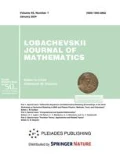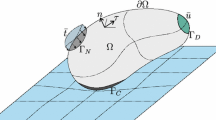Abstract
The paper is dedicated to the construction of a computational algorithm for the investigation of solids, taking into account the material and geometric nonlinearity and contact interaction. In the framework of the previously developed algorithm for the investigation of large elastoplastic deformations of solids the solutions of contact problems are derived. The algorithm has been based on the equation of the principle of virtual work in velocity terms. Contact interaction is modeled over the basis of the master-slave approach with penalty method. The closest point projection procedure is used to find the contact area. For the solution of the nonlinear system of equations incremental method is applied. The numerical implementation is based on the finite element method.





Similar content being viewed by others
REFERENCES
A. I. Golovanov, ‘‘Numerical modeling of large deformations of elastoplastic solids in terms of logarithms of principal stretches,’’ Comput. Continuum Mech. 4, 25–35 (2011).
A. A. Rogovoi, ‘‘Kinematics of finite-strain elastic-inelastic deformation,’’ J. Appl. Mech. Tech. Phys. 49, 136–141 (2008).
V. G. Bazhenov, M. S. Baranova, A. I. Kibets, V. K. Lomunov, and E. V. Pavlenkova, ‘‘Buckling of elastic–plastic cylindrical and conical shells of revolution under axial impact loading,’’ Uch. Zap. Kazan. Univ., Ser. Fiz.-Mat. Nauki 152 (4), 86–105 (2010).
J. S. Simo and C. Miehe, ‘‘Associative coupled termoplasticity at finite strains: Formulation, numerical analysis and implementation,’’ Comput. Methods Appl. Mech. Eng. 98, 41–104 (1992).
Y. Basar and A. Eckstein, ‘‘Large inelastic strain analysis by multilayer shell elements,’’ Acta Mech. 141, 225–252 (2000).
B. Yang and T. A. Laursen, ‘‘A large deformation mortar formulation of self contact with finite sliding,’’ Comput. Methods Appl. Mech. Eng. 197, 756–772 (2008).
D. M. Neto, M. C. Oliveira, and L. F. Menezes, ‘‘Surface smoothing procedures in computational contact mechanics,’’ Arch. Comput. Methods Eng. 24, 37–87 (2017).
P. Wriggers, Computational Contact Mechanics (Wiley, UK, 2002).
P. Wriggers, ‘‘Finite element algorithms for contact problems,’’ Arch. Comput. Methods Eng. 24, 1–49 (1995).
T. A. Laursen, ‘‘Convected description in large deformation frictional contact problems,’’ Int. J. Solids Struct. 31, 669–681 (1994).
T. A. Laursen, Computational Contact and Impact Mechanics (Springer, Berlin, 2002).
D. M. Neto, M. C. Oliveira, and L. F. Menezes, ‘‘Surface smoothing procedures in computational contact mechanics,’’Arch. Comput. Methods Eng. 24, 37–87 (2017).
A. Konyukhov and K. Schweizerhof, Computational Contact Mechanics—Geometrically Exact Theory for Arbitrary Shaped Bodies (Springer, Heidelberg, 2012).
J. S. Simo and T. A. Laursen, ‘‘An augmented lagrangian treatment of contact problems involving friction,’’ Comput. Struct. 42, 97–116 (1992).
E. Lee, ‘‘ Elastic–plastic deformation at finite strains,’’ J. Appl. Mech. 36, 1–6 (1969).
J. S. Simo, ‘‘A framework for finite strain elastoplasticity based on maximum plastic dissipation and the multiplicative decomposition: Part I. Continuum formulation,’’ Comput. Methods Appl. Mech. Eng. 66, 199–219 (1988).
C. Miehe, ‘‘A theory of large-strain isotropic thermoplastisity based on metric transformation tensor,’’ Arch. Appl. Mech. 66, 45–64 (1995).
B. Eidel and F. Gruttmann, ‘‘Elastoplastic orthotropy at finite strains: Multiplicative formulation and numerical implementation,’’ Comput. Mater. Sci. 28, 732–742 (2003).
J. Schröder, F. Gruttmann, and J. Löblein, ‘‘A simple orthotropic finite elasto-plasticity model based on generalized stress-strain measures,’’ Comput. Mech. 30, 48–64 (2002).
L. U. Sultanov, ‘‘Analysis of finite elastic-plastic deformations: Kinematics and constitutive equations,’’ Uch. Zap. Kazan. Univ., Ser. Fiz.-Mat. Nauki 157 (4), 158–165 (2015).
L. U. Sultanov, ‘‘Analysis of large elastic-plastic deformations: Integration algorithm and numerical examples,’’ Uch. Zap. Kazan. Univ., Ser. Fiz.-Mat. Nauki 159, 509–517 (2017).
A. I. Golovanov and L. U. Sultanov, ‘‘Postbuckling elastoplastic state analysis of three-dimensional bodies taking into account finite strains,’’ Russ. Aeronaut. 51, 362–368 (2008).
J. Bonet and R. D. Wood, Nonlinear Continuum Mechanics for Finite Element Analysis (Cambridge Univ. Press, U.S.A., 1997).
R. L. Davydov and L. U. Sultanov, ‘‘Numerical algorithm of solving the problem of large elastic-plastic deformation by FEM,’’ PNRPU Mech. Bull. 1, 82–93 (2013).
A. I. Abdrakhmanova and L. U. Sultanov, ‘‘Numerical investigation of nonlinear deformations with contact interaction,’’ Uch. Zap. Kazan. Univ., Ser. Fiz.-Mat. Nauki 160, 423–434 (2018).
M. Al-Dojayli and S. A. Meguid, ‘‘Accurate modeling of contact using cubic splines,’’ Finite Elem. Anal. Des. 38, 337–352 (2002).
N. G. Burago, A. B. Zhuravlev, and I. S. Nikitin, ‘‘Analysis of stress state of GTE contact system ‘disk-blade’,’’ Comput. Continuum Mech. 4 (2), 5–16 (2011).
I. B. Badriev and V. N. Paimushin, ‘‘Refined models of contact interaction of a thin plate with positioned on both sides deformable foundations,’’ Lobachevskii J. Math. 38, 779–793 (2017).
H. Parisch, ‘‘A formulation of arbitrarily shaped surface elements for three dimensional large deformation contact with friction,’’ Int. J. Numer. Methods Eng. 40, 3313–3324 (1997).
M. A. Puso, ‘‘A 3D contact smoothing method using Gregory patches,’’ Int. J. Numer. Methods Eng. 54, 1161–1194 (2002).
J. T. Oden, Finite Elements of Nonlinear Continua (McGraw-Hill, New York, 1972).
R. Izi, A. Konyukhov, and K. Schweizerhof, ‘‘Large penetration algorithm for 3D frictionless contact problems based on a covariant form,’’ Comput. Methods Appl. Mech. Eng. 217–220, 186–196 (2012).
M. A. Puso, T. A. Laursen, and J. Solberg ‘‘A segment-to-segment mortar contact method for quadratic elements and large deformations,’’ Comput. Methods Appl. Mech. Eng. 197, 555–566 (2008).
B. Yang, T. A. Laursen, and X. Meng, ‘‘Two dimensional mortar contact methods for large deformation frictional sliding,’’ Int. J. Numer. Methods Eng. 62, 1183–1225 (2005).
K. F. Chernykh, Nonlinear Theory of Elasticity in Machine-Building Calculations (Mashinostroenie, Leningrad, 1986) [in Russian].
Funding
The reported study was supported by Government of the Republic of Tatarstan research projects and RFBR research projects nos. 18-41-160021, 18-41-160018.
Author information
Authors and Affiliations
Corresponding author
Additional information
(Submitted by D. A. Gubaidullin)
Rights and permissions
About this article
Cite this article
Sultanov, L.U. Computational Algorithm for Investigation Large Elastoplastic Deformations with Contact Interaction. Lobachevskii J Math 42, 2056–2063 (2021). https://doi.org/10.1134/S199508022108031X
Received:
Revised:
Accepted:
Published:
Issue Date:
DOI: https://doi.org/10.1134/S199508022108031X




